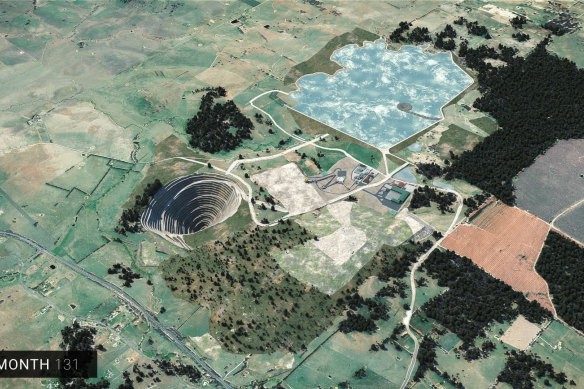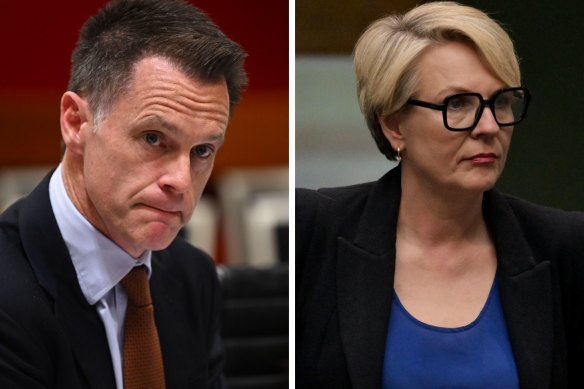By Max Maddison
The NSW government is considering an unprecedented use of planning powers to approve a modified proposal for the $1 billion Blayney gold mine, just weeks after a critical part was kiboshed by federal Environment Minister Tanya Plibersek.
Documents obtained through a NSW parliamentary order for papers reveal the Department of Planning, Housing and Infrastructure (DPHI) is considering a fast-tracked planning route that was first floated by mining company Regis Resources over concerns about the time required to resubmit a full proposal.

An illustration of the McPhillamys mine, with Kings Plain houses in the bottom left.Credit: Regis Resources
The Blayney gold mine, about 30 kilometres south of Orange in the state’s central west, became the subject of a political fight after Plibersek vetoed a section of the plan because of concerns about Aboriginal cultural heritage.
Plibersek’s partial section 10 declaration stopped the miner from building a tailings dam – which stores byproducts of mining operations – at the headwaters of the nearby Belubula River. Regis Resource’s chief executive Jim Beyer said the decision meant the project was no longer viable given an alternative tailings dam proposal could set them back a decade.
Premier Chris Minns expressed his disappointment with the decision of his federal Labor colleague at the time, describing the state’s assessment as “rigorous”. He said submissions by the Orange Aboriginal Land Council, one of the elected Indigenous bodies in the region, had been important in the approval.
Emails among the documents released to parliament show Regis has sought an expedited planning pathway, known as State Significant Infrastructure (SSI) or Critical State Significant Infrastructure (CSSI). Approval under SSI would leave Planning Minister Paul Scully as the consent authority, rather than the Independent Planning Commission (IPC).
The IPC originally approved the decision in March last year but required Plibersek’s sign-off before it could proceed.
Plans for the alternative application pathway were first proposed during a phone call between Regis Resources and DPHI deputy secretary David Gainsford, according to an email sent on September 20.
A briefing note states SSI/CSSI has historically not been used as a planning pathway for mines but as “public authorities and complex linear infrastructure”, and it raises concerns about setting a precedent for similar projects to use the unorthodox route.

NSW Premier Chris Minns and federal Environment Minister Tanya Plibersek are at odds over a proposed gold mine in the NSW Central West.Credit: Janie Barrett; Getty
“Declaring the mine as SSI/CSSI would likely be perceived as the government attempting to avoid the decision going to the IPC or being appealed in the Land and Environment Court,” the briefing note states.
“It would also set a precedent and might lead to a large number of other requests in the housing, renewable energy and mining space.”
Senior members of Minns’ office were included in the September 20 email. The briefing note was forwarded to DPHI secretary Kiersten Fishburn and Department of Primary Industries and Regional Development secretary Steve Orr, with only “as discussed” included in the body.
In response to questions, Scully said: “The government is unable to consider a Critical State Significant Infrastructure or State Significant Infrastructure declaration until receiving an application for a project.”
But emails show there were departmental concerns about the robustness of assessing Indigenous cultural values and questions were raised about the extent of the Indigenous heritage assessment undertaken as part of the mine’s original application.
The documents reveal a flurry of internal departmental activity responding to a letter from Plibersek on December 11 last year seeking the views of the NSW government in relation to the McPhillamys Gold Mine.
Asked whether the gold mine is compliant with regulatory requirements in NSW, including the Aboriginal Cultural Heritage Assessment Report, an Aboriginal Affairs NSW director agreed but also acknowledged “limitations” with the framework.
The IPC found “that harm to Aboriginal heritage, including intangible Aboriginal cultural heritage can be acceptably managed through conditions of consent” as part of the decision to approve the site.
Scully said the state had a “robust framework for recognising and protecting Aboriginal cultural values … respecting both tangible and intangible heritage in the development process”.
Start the day with a summary of the day’s most important and interesting stories, analysis and insights. Sign up for our Morning Edition newsletter.